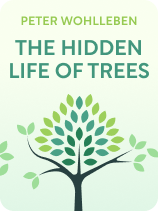

This article is an excerpt from the Shortform book guide to "The Hidden Life of Trees" by Peter Wohlleben. Shortform has the world's best summaries and analyses of books you should be reading.
Like this article? Sign up for a free trial here.
How do trees cooperate with each other? Are trees sentient? What sustainable forestry practices can help protect forests?
In The Hidden Life of Trees by Peter Wohlleben, he delves deep into the world of old-growth forests, unveiling secret interactions, intricate networks, and fascinating behaviors among trees. The book emphasizes the importance of conserving these vital ecosystems and seeing them as living entities.
Continue reading for an overview of Wohlleben’s book, including key takeaways and actionables.
The Hidden Life of Trees: What They Feel, How They Communicate
In The Hidden Life of Trees by Peter Wohlleben, he draws on scientific research and his experience as a forester to shed light on the astonishing ways trees interact with their environment and one another. Amid deforestation and climate change, understanding the intricate lives of trees offers insights into their innate value and why it’s important to protect them. The Hidden Life of Trees invites us to look at forests with renewed wonder and appreciation, emphasizing the importance of conserving these vital ecosystems and seeing them not just as resources but as living entities deserving our respect and protection.
Wohlleben, a German forester and activist, was a civil servant in the state forestry administration for over 20 years, eventually founding the Forest Academy to provide training in sustainable forest management. In addition to The Hidden Life of Trees (2015), Wohlleben has also published several other books, including The Heartbeat of Trees (2021) and The Power of Trees (2023). Wohlleben is recognized as a global advisor on forestry issues and has received several awards for his work, including the Heinz Sielmann Award and the Environmental Award from Environmental Action Germany. A documentary film adaptation of The Hidden Life of Trees was released in 2021.
In this guide, we’ll begin by exploring some of the characteristics of trees and forests that make them so remarkable, explaining how the complex interactions of trees warrant greater respect and admiration. We’ll go on to demonstrate why forests are important to our global ecosystem and offer ideas for how we can better support and protect the world’s old-growth forests. Throughout the guide, we’ll discuss the scientific basis of Wohlleben’s work and compare his conclusions with those of other ecologists and environmental activists, including Suzanne Simard (Finding the Mother Tree) and Robin Wall Kimmerer (Braiding Sweetgrass).
(Shortform note: While Wohlleben sometimes uses the terms “tree” and “forest” interchangeably, the book focuses on the specific value of old-growth forests—forest ecosystems that have developed over long periods without experiencing significant human-caused disturbances such as logging, clearing, or infrastructure development.)
The Complex Lives of Trees
Wohlleben argues that throughout history, humans have thought of trees primarily as resources, but he argues that trees are far more complex and intelligent than we’ve previously thought. Wohlleben explains that trees, like animals, are capable of cooperation, communication, and even sentience often imperceptible to human observers. This shift in understanding can dramatically alter how we interact with and care for our forests.
Trees Cooperate
First, Wohlleben explains how trees in old-growth forests cooperate, sharing nutrients with one another and establishing reciprocal relationships with other species.
Trees Cooperate by Sharing Resources
Trees in a forest function as critical support systems for each other, particularly when it comes to weathering severe environmental conditions. Older trees provide shelter for younger ones, creating a canopy that offers protection from harsh weather. Then, when younger trees are more established, older trees die, creating space for smaller trees to grow. Together, they form a communal living space, mitigating the harshness of the weather and creating small local climates that support their survival.
Additionally, writes Wohlleben, trees in a forest exhibit a remarkable level of cooperation in sharing nutrients. They maintain a uniform rate of photosynthesis, hinting at a shared system of nutrient distribution. Wohlleben attributes this to an intricate underground network of roots and beneficial fungi that work in tandem to extract and distribute essential nutrients, especially sugars, from the soil. This system functions much like the diverse organisms within the soil that decompose organic matter and recycle nutrients, contributing to maintaining a healthy and sustainable ecosystem.
Trees Cooperate With Other Species
Wohlleben says that trees don’t just cooperate with other trees but also have reciprocal relationships with other organisms, like fungi. Unlike trees, fungi can’t photosynthesize independently. Instead, they form organic connections with plants, like trees, to receive essential sugars and other carbohydrates. In return, the fungi spread through tree roots, creating an extensive mycelial network that dramatically increases an individual tree’s root surface area, allowing it to absorb more water and nutrients. The mycelial web also interconnects the roots of various trees, promoting nutrient exchange among them. Fungi also act as guardians for their tree partners, filtering out toxins and warding off harmful bacteria or other antagonistic fungi.
None of this cooperation is possible if a tree is isolated, says Wohlleben. These relationships only occur in natural forests. An individual tree can’t build a friendly microclimate, moderate temperature, protect seedlings from a storm or unrelenting sunlight, or share nutrients. Forests that have been planted by humans also fail to replicate this intimate network. As Wohlleben points out, planted trees often have damaged root systems that fail to create the rich root networks characteristic of long-standing forests.
Trees Communicate
Wohlleben argues that trees not only support each other, but they communicate with each other as well. While trees don’t use human-like languages, they still have ways of talking to each other. Wohlleben explains that trees use chemical signals, smell, and maybe even sound to communicate with each other.
Electrochemical Communication
According to Wohlleben, one of the ways in which trees communicate is through chemical signals and electrical impulses. Research has shown that trees can warn each other of potential dangers through a vast underground network of fungi that connect the roots of trees and other plants in a forest, playfully termed the “wood wide web.” Through these networks, trees send chemical compounds that act as messages, conveying information about threats like insects, drought, and other environmental stressors. This means that if one tree detects an insect infestation, it can send out a chemical alert to its neighbors, allowing them to prepare and defend themselves.
But the communication doesn’t stop at chemical compounds, writes Wohlleben. Research indicates that trees also use electrical impulses to relay information. While these impulses travel at a pace of a third of an inch per second—a speed that may seem almost glacial compared to the rapid communication in our own bodies—it is still an efficient way for trees to exchange vital information over distances.
Olfactory Communication
Wohlleben contends that another way trees communicate with each other is through smell. By releasing and detecting scents in their surroundings, trees can send out warnings and solicit help.
When trees are attacked by hungry herbivores or insects, they release scent compounds or gases that warn other trees of the threat. For example, when giraffes begin feeding on an African acacia tree, the tree responds immediately by increasing the production of a toxic compound called tannin to make its leaves less palatable. At the same time, the tree releases a cloud of ethylene gas as a warning to neighboring acacias. Upon detecting this ethylene gas, nearby acacia trees pre-emptively increase their own tannin production, even before the giraffes reach them. This quick olfactory communication helps protect the trees from being overly grazed by the herbivores.
Wohlleben says that trees also release specific scents to attract beneficial insects to aid in pollination and protection. For instance, when certain trees are attacked by pests, these trees can emit pheromones that attract the natural predators of those pests. While this might seem like a chemical defense mechanism, it’s also a form of olfactory communication, signaling to beneficial species that there’s a food source (the pests) available. For example, when trees sense they’re being attacked by leaf-eating caterpillars, the trees are able to attract parasitic wasps who lay their eggs inside the caterpillars.
Auditory Communication
Wohlleben also touches upon research that suggests that trees might communicate using sound. Researchers have discovered that the roots of plants, including trees, produce a crackling noise at a frequency of 220 Hz. While the reason behind these noises isn’t clear, some evidence suggests they might be related to cell-to-cell communication or the movement of water and sap. More intriguingly, there’s evidence that trees and plants can respond to these sounds. In controlled experiments, researchers have found that roots will often grow toward a source of continuous sound at the 220 Hz frequency. This suggests that trees might be using these sounds either to communicate with each other or to sense their environment.
The exact mechanism underlying sound communication among trees is still a matter of research and debate, says Wohlleben. Some speculate it could be a form of echolocation, helping trees sense the layout of their surroundings. Others think it might be a more direct form of communication, with trees sending signals to each other about environmental conditions, threats, or other vital information. While this research is still in its infancy, as Wohlleben points out, every new discovery about trees challenges our previous understanding and shows just how complex and interconnected forest ecosystems really are.
Trees Are Sentient
Finally, Wohlleben proposes the idea that trees are sentient. While Wohlleben doesn’t claim trees have consciousness or emotions in the way humans do, he suggests that they exhibit behaviors and responses that indicate a level of sensitivity to and awareness of their surroundings which could be described as sentience.
According to Wohlleben, trees’ root systems have similarities with the human brain. He explains how roots, much like our neurons, transmit signals and share information, forming a sophisticated communication network. This unseen tree “brain” isn’t centralized as it is in humans, but spread out below ground, with each root tip acting like a mini control center. This root tip allows trees to detect water, absorb nutrients, and even interact with neighboring trees, sharing resources and sending distress signals.
Wohlleben offers three additional pieces of evidence to support his argument that trees are sentient:
- Trees are capable of learning.
- Trees have a sense of time.
- Trees have distinct personalities.
In the next section, we’ll discuss each piece of evidence in greater depth.
Trees Are Capable of Learning
First, Wohlleben argues that trees are capable of learning based on their ability to adapt to changing environmental conditions. For example, trees that have survived intense droughts store more water in the subsequent years, indicating a type of memory and ability to learn from previous hardships. Wohlleben also notes how trees in crowded forests moderate their growth rates to avoid overshadowing nearby trees, illustrating a sense of spatial awareness and knowledge of their surroundings.
Trees Have a Sense of Time
Wohlleben also argues trees have a sense of time rooted in their innate biological rhythms and cycles. He points out that trees follow a yearly cycle of growth and dormancy that aligns with the changing seasons, suggesting they have an internal clock that guides their activities. For instance, trees know when to sprout and drop their seeds to ensure the maximum chance of survival. Trees of the same species even produce seeds at the same time to ensure the genes of individual trees are well-mixed. Similarly, trees know when to shed their leaves in the fall to conserve resources for the winter, and when to resume growth in the spring when resources are abundant.
Trees Have Distinct Personalities
Finally, making his case for tree sentience, Wohlleben also argues that trees, like humans or other animals, have distinct personalities. He observes that individual trees, even when growing in the same soil and under the same microclimate, sometimes change color and shed their leaves at different times. This variation, he suggests, isn’t merely a response to environmental factors, but a matter of individual choice, suggesting a unique character or personality.
Similarly, says Wohlleben, while it is generally more advantageous for trees to invest energy into branches at their crown, where they can absorb more sunlight, not all trees follow this strategy. In a forest clearing, for instance, some trees choose to sprout new branches on their trunk, while others don’t. Wohlleben interprets this as another sign of individual choice or character, further supporting his argument that trees exhibit a form of sentience.
Why Does the Complexity of Trees Matter?
According to Wohllben, trees’ ability to cooperate, communicate, and respond to their environment in ways that resemble intelligence should compel us to re-evaluate our perception of forests. First, there are practical implications for how we manage forests. For example, if trees are interdependent and communicate, then the felling of one tree isn’t simply the removal of an individual, but a disturbance to a community. Furthermore, acknowledging trees’ sentience could pivot forestry practices toward more sustainable logging, land usage, and conservation efforts that respect and prioritize the well-being of trees and forests.
Beyond the pragmatic, Wohlleben’s ideas extend into the philosophical realm, encouraging us to broaden our understanding of community and cooperation beyond the confines of the human and animal spheres. This perspective invites a rethinking of our relationship with nature and our roles as environmental stewards and promotes a heightened respect for the lives of trees.
The Importance of Trees
While Wohlleben argues that trees are innately valuable, he also explains how they’re crucial to the survival of numerous species, including humans. In this section, we’ll highlight trees’ important role in the global ecosystem and explain the sometimes unexpected ways in which humans, and other species, depend on them to survive.
Forests Help Control Our Climate
First of all, Wohlleben explains, forests help regulate our climate on a regional and global level.
Forests help maintain regional climates through their role in the hydrological cycle, or the way water moves around the world. Trees absorb vast amounts of water from the soil through their root systems and release it into the atmosphere via transpiration. This action serves as a natural water pump, converting groundwater into water vapor, which forms clouds that can travel great distances to deliver rain to even the remotest areas. Without this forest-driven process and without healthy coastal forests, where the process begins, many landlocked regions would become arid deserts.
Finally, Wohlleben says mature forests mitigate climate change on a global scale, primarily due to their significant capacity for carbon sequestration. As trees age and grow, they store vast amounts of carbon in their trunks, branches, leaves, and roots. Furthermore, the forest floor in mature forests accumulates thick layers of organic matter and fallen leaves, leading to the formation of a rich soil, known as humus, which stores additional carbon. However, if these trees are cut down and burned, the carbon is rereleased into the atmosphere as carbon dioxide (CO2).
Forests Are Key to Biodiversity
According to Wohlleben, trees are also crucial to sustaining our planet’s biodiversity, the variety of life on earth. Old-growth forests are particularly rich in biodiversity, providing the ideal habitat for myriad plants, animals, fungi, and microorganisms.
Trees serve as essential physical habitats for numerous species. Caterpillars munch on their leaves, birds nest on their branches, and fungi colonize their roots. Some species, such as woodpeckers and beetles, make their homes inside trunks, and others like mosses and lichens grow on their bark. Trees even continue to provide habitats after they’re dead: When trees die and decompose, they become nurse logs, providing nutrition and housing for a range of organisms from fungi and mosses to insects and small mammals.
However, Wohlleben adds, trees don’t just provide physical spaces; they also create friendly microclimates. By forming dense canopies, trees moderate temperature fluctuations, control humidity levels, and reduce wind speeds, effectively giving rise to environments that can support a diverse range of organisms not usually found in the open.
Additionally, trees play a crucial role in nutrient cycling. Wohlleben explains that as they drop their leaves, the leaves decompose and return the extracted nutrients back into the soil. This ultimately makes these nutrients accessible to the diverse life forms living beneath the forest floor. According to Wohlleben, there are as many organisms in a small handful of soil as there are people in the world, and still more yet to be discovered. Soil-dwelling species, from microscopic organisms to larger creatures like mites, play indispensable roles in maintaining a healthy ecosystem by decomposing organic matter and recycling nutrients.
However, says Wohlleben, when old-growth forests are harvested or replaced by more commercially viable mono-cropped tree plantations, these intricate and balanced soil communities are dismantled. Soil compaction, pollution, and alterations to the microhabitat from traditional forestry practices additionally jeopardize the survival of these organisms, which disrupts nutrient cycling and reduces the overall biodiversity of the region. Less biodiversity makes the ecosystem less resilient to changes, like diseases or climate change, which can further degrade the environment.
Our Responsibility to Forests
Ultimately, The Hidden Life of Trees is a call to action. Despite trees’ remarkable ability to adapt to massive shifts in climate and their high degree of genetic variation, which guards against total extinction, Wohlleben argues trees still need our help. He advocates for a more holistic, empathetic, and sustainable approach to our stewardship of forests.
First, if logging is a necessity, Wohlleben strongly advises implementing sustainable forestry practices. He stresses the importance of fostering forests with a mix of tree species and ages, as this strengthens biodiversity and protects against disease. He also advocates for minimal human intervention. Instead of clear-cutting, or removing large amounts of trees at once, Wohlleben recommends selective logging, a method that only removes a few trees at a time to preserve the overall health of the forest and allows trees to grow, age, and decay naturally. Moreover, selective, intermittent logging allows trees sufficient time for maturation and regeneration.
Wohlleben offers additional innovative ways to protect forests and ensure their continued usefulness. One method gaining traction in some countries is the introduction of arboreal mortuaries, where cremated human remains are interred at the base of existing trees, providing nutrients to the tree and preserving the forest’s natural integrity. Arboreal mortuaries repurpose forests as cemeteries and protect them from unnecessary logging. Wohlleben also advocates for educational tourism opportunities that allow people to experience and learn about forest ecosystems, further fostering an appreciation that drives forest preservation.
Finally, Wohlleben argues that the best thing we can do for forests is to recognize their innate value and leave them alone to live out their lives with dignity.
Exercise: Reflect on the Complex Lives of Trees
In writing The Hidden Life of Trees, Wohlleben’s goal was to teach people about trees and, hopefully, to change their perception of trees.
- What is the most surprising thing you learned about trees while reading? Why did this surprise you?
- How has your perception of trees changed after reading this book? How do you think of trees differently?
- How would you explain the main concepts presented in the book to a friend or family member who hasn’t read it?
- What action, if any, are you motivated to take after reading this book?

———End of Preview———
Like what you just read? Read the rest of the world's best book summary and analysis of Peter Wohlleben's "The Hidden Life of Trees" at Shortform.
Here's what you'll find in our full The Hidden Life of Trees summary:
- The characteristics of trees and forests that make them so remarkable
- How trees in old-growth forests cooperate and communicate
- Actionables that humans can take to help protect the forests






